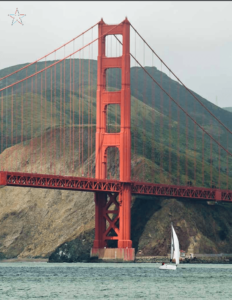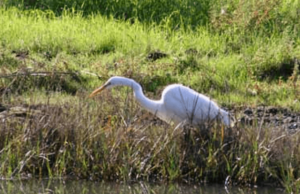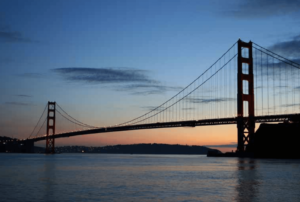California Cleaning
By: San Francisco Baykeeper
A score of lawsuits is using the Clean Water Act to restore the health of legendary San Francisco Bay.
By Deb Self, San Francisco Baykeeper
Using the citizen suit provision of the Clean Water Act, San Francisco Baykeeper has succeeded in forcing dramatic reductions in sewage spills and overflows into San Francisco Bay. For years, sewage spills in the Bay Area have been steadily worsening as cities have deferred maintenance and repairs to sewage systems. Most of these systems were built to serve smaller populations in the 1950s and 60s and they are now in dire need of upgrades and repairs. During the winter rainy season, large amounts of rainwater seep into the sewer systems through crumbling pipes or through connections between the sewer and storm drain systems. This swells the volume of water flowing into treatment plants, which can overwhelm treatment-plant capacity and cause hundreds of millions of gallons of partially treated and untreated sewage to be discharged into local watersheds. During the particularly rainy winter of 2010-11, nearly a quarter-billion gallons of sewage and contaminated rainwater were released into the San Francisco Bay and local waterways.

But relief is on the way. Baykeeper has waged a multi-year campaign to hold cities and sewer agencies responsible for their pollution. Under the Clean Water Act, we have secured settlements compelling the cleanup of sewage spills in 20 Bay Area cities and sewage districts. We have the worst polluters on a path to success.
Despite the sewage pollution, the San Francisco Bay-Delta Estuary is one of the most ecologically productive water bodies in the world. Open-water habitats, intertidal mudflats, rocky shores, salt ponds, marshes, riparian forests and vernal pools all form the iconic water body that defines the character and community of the Bay Area.
A diverse wildlife community and commercial fishery once thrived here and can flourish again. Millions of migratory shorebirds using the Pacific Flyway depend on the Bay as a resting spot. Twenty-two threatened or endangered species, including the snowy plover and the mission blue butterfly, are found in the watershed. Hundreds of rare and endemic plants grow in the wide variety of environmental conditions unique to the Bay Area.
Recreationists ply the bay’s waters, including sailors, motor boaters, surfers, stand-up paddle boarders, kiters, kayakers, canoeists and swimmers. Hikers and cyclists are regulars along the shore.
Sewage is a major threat to the bay’s health. Sewage can deplete oxygen in the bay, threatening fish, seals, other sea creatures, and plant life. Sewage spills also contain bacteria, viruses and other pathogens. When fishermen, windsurfers, swimmers and others come in contact with water contaminated with sewage, it can cause persistent skin infections and painful stomach disorders.

Five years ago, with sewage spills increasing as crumbling pipes went neglected by cities throughout the Bay Area, Baykeeper began examining individual system spill rates and determining the worst offenders. We took advantage of a state law that requires every public agency running a sewer system in California to file monthly reports showing how many spills their systems suffered and how much was spilled. The data is posted on the Internet.
Baykeeper discovered that failing sewer systems in the East Bay (across the bay from San Francisco) were releasing millions of gallons of under treated sewage into the bay. On the Peninsula – directly south of San Francisco – systems regularly spilled raw sewage into storm drains, creeks, sloughs and the bay. We launched our Sick of Sewage campaign in 2008 to force the worst polluters to stop spilling sewage into the bay and to raise public awareness of the harm caused by sewage spills.
Since then, we’ve made significant progress. Baykeeper has negotiated legally binding agreements requiring major capital upgrades to crumbling sewage infrastructure in 20 of the Bay Area’s worst-performing cities and sewage districts. These include the Peninsula cities of Atherton, Burlingame, Burlingame Hills, Hillsborough, Menlo Park, Millbrae, Portola, San Bruno, San Carlos, and South San Francisco, along with the East Bay cities of Alameda, Albany, Berkeley, Emeryville, Oakland, Piedmont, Richmond, Vallejo and the Stege Sanitary District, which serves El Cerrito and nearby communities.

One particular challenge was our case against the West Bay Sanitary District, which serves Menlo Park, Atherton, Portola Valley and surrounding areas. We first brought suit against West Bay in 2009, after documenting hundreds of sewage spills over six years into creeks and sloughs that flow into the Bay. In all more than 60,000 gallons of sewage polluted popular recreation areas and vital spawning grounds for threatened steelhead trout.
Though their liability was clear, West Bay was utterly opposed to admitting their responsibility under the Clean Water Act. They spent two years fighting our lawsuit, including making several public attacks on Baykeeper’s integrity, and despite a federal summary judgment ruling in May 2011 that found them liable for a number of the spills.
We held firm in defense of a healthy bay, and discovered that even while West Bay was objecting, they were busy implementing our recommended fixes to upgrade their leaking sewer pipes. In January, West Bay agreed to a settlement, conceding that Baykeeper’s legal action was a significant factor in their decision to begin making upgrades. In just two years, West Bay—once one of the worst-performing sewage agencies in the Bay Area—has reduced sewage spills by two-thirds as a result of our Clean Water Act suit.
Other sewage agencies we sued have been more cooperative. Here’s what Chad Davisson, Richmond’s wastewater manager, told the San Jose Mercury News: “It never is easy to go out to the ratepayers and ask for more money to make improvements. But I think the suit and the settlement have helped us focus on the need to get it done. We want to be good stewards of the Bay.”

Baykeeper is now actively monitoring cities’ and sewage districts’ compliance with the terms of our legal settlements as they implement major upgrades over the next five to ten years. The 2010 results of our early settlements with Burlingame, Burlingame Hills, Hillsborough, Millbrae and San Carlos demonstrated dramatic 50 percent reductions in their numbers of sewage spills after the sewage agencies improved maintenance practices and repaired broken pipes. We’re now analyzing the 2011 results from our settlements, including reviewing new master plans from seven East Bay cities to upgrade their hundreds of miles of leaking sewer pipes in order to rein in massive overflows of undertreated sewage into the bay.
With continued monitoring of the cities where we have Clean Water Act settlements, Baykeeper expects to achieve steep reductions in sewage spills to the bay. Within the next 10 years, we believe sewage spills will cease to be a major threat to the health of the San Francisco Bay, its wildlife and recreational users, thanks to our efforts and to the citizen suit provision of the Clean Water Act.